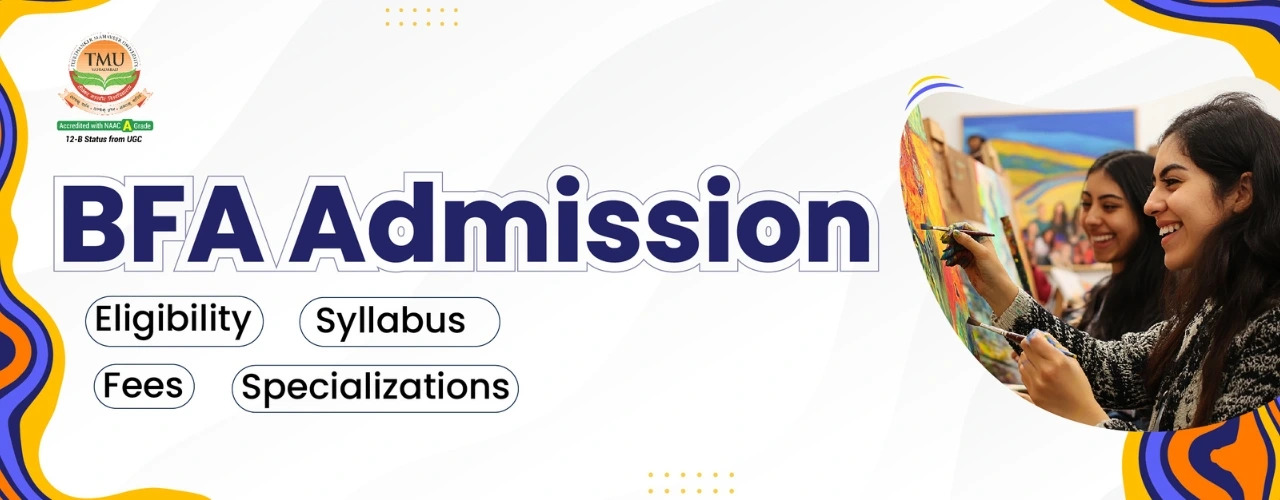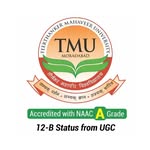BFA Admission 2025: Eligibility, Syllabus, Specialisations & Fees
Table of Contents
The Bachelor of Fine Arts (BFA) is an undergraduate degree programme designed for individuals with a strong passion for creativity and visual expression. Unlike traditional academic degrees that primarily focus on theoretical knowledge, a BFA emphasises practical artistic training, technical skills, and the development of a unique artistic voice. It's a professional degree that delves into various art forms, including visual arts, applied arts, and sometimes even performing arts.
BFA is more than just about drawing or painting—it includes various aspects of visual arts, performing arts, applied arts, and digital design. Over the years, the scope of BFA has expanded with the inclusion of contemporary practices like animation, game design, and multimedia storytelling. Many institutions now offer specialised courses tailored to modern industry needs, combining traditional techniques with digital innovation.
The degree typically spans 4 years, depending on the country or university structure. The programme emphasises hands-on studio practice, critique-based learning, and academic explorations of art history and aesthetics.
Importance of BFA in Creative Careers
A BFA can provide entry into diverse, high-growth creative industries in today's visual-driven world. From advertising and animation to fashion and interior design, the demand for skilled artists is on the rise. Employers no longer just look for academic excellence—they want creative thinkers who can translate abstract concepts into powerful visuals or performances.
Furthermore, a BFA graduate isn't limited to job-seeking. The degree fosters an entrepreneurial spirit, encouraging students to launch their own studios, exhibit their artwork, or even monetise their work through online platforms. The fusion of art with technology has further expanded opportunities, making BFA graduates crucial contributors to everything from UI/UX design to branding and visual storytelling.
With the rise of digital content, every brand now needs visuals—be it through illustrations, video editing, or motion graphics. And that’s where BFA graduates shine, making the course incredibly relevant and future-proof.
Teerthanker Mahaveer University
Apply for Admission
Click Here To Apply for Admission
BFA Course Overview
Duration and Type of Course
The BFA is typically a 4-year undergraduate degree programme. It is primarily offered as a full-time course, involving intensive studio work and practical sessions. Some universities may offer part-time or distance education options, but for a comprehensive artistic development, full-time study is generally recommended.
Core Curriculum Overview
A BFA curriculum is a blend of theoretical knowledge and hands-on practical training. Students learn about art history, design principles, and various artistic techniques. The program encourages experimentation with different mediums and styles, fostering creative problem-solving and the development of a personal artistic style.
A typical BFA course includes:
- Art History
- Visual Communication
- Fundamentals of Drawing and Design
- Painting Techniques
- Digital Arts and Animation
- Photography and Videography
- Studio Practices
- Project Work and Portfolio Development
BFA Course Overview Table
Here’s a quick table to help you understand the BFA course structure at a glance:
| Aspect | Details |
| Full Form | Bachelor of Fine Arts |
| Course Type | Undergraduate |
| Duration | 3-4 Years (6-8 Semesters) |
| Mode | Full-Time |
| Eligibility | 10+2 from a recognised board |
| Admission | Merit-Based or Entrance Test |
| Specialisations | Painting, Applied Arts, Sculpture, Animation, Multimedia, Photography |
| Average Fees | ₹30,000 to ₹2,00,000 per year (varies by college) |
| Top Recruiters | Advertising Agencies, Animation Studios, Art Galleries, Media Houses |
| Average Salary | ₹2.5 – ₹6 LPA (depends on skill and experience) |
Eligibility Criteria for BFA Admission
Educational Qualification Requirements
To be eligible for admission into a BFA program, candidates must have completed their 10+2 or equivalent education with a recognised board. While most institutions accept students from any stream—Arts, commerce, or science—some may prefer candidates with an arts background due to the alignment with creative subjects.
A few universities might ask for basic art knowledge or skills, although that’s typically tested during entrance exams or portfolio reviews rather than through academic scores alone.
Institutions like the College of Art (Delhi), Sir JJ School of Art (Mumbai), and MSU Baroda have specific eligibility guidelines, often demanding a higher percentage or artistic aptitude tests.
Age Limit and Nationality Criteria
There is generally no strict upper age limit for BFA admissions. However, most students enrolling in this program are between 17 to 25 years old. Some institutions may have age restrictions if the course is part of an integrated program or government-aided scheme.
As for nationality, Indian institutions primarily admit Indian citizens, but several universities also offer seats for NRIs and international students, often with separate admission processes and fee structures.
Minimum Marks and Entrance Exams
Minimum marks required vary, but a 50% aggregate in 10+2 is a safe benchmark for many reputed colleges. For elite institutions, a higher percentage (above 60%) might improve admission chances, especially in merit-based selections.
In entrance-based admissions, students might need to pass an aptitude test, which typically includes:
- Drawing and sketching test
- General knowledge of art
- Portfolio assessment
- Interview (in some cases)
Top entrance exams for BFA include:
- NID DAT (National Institute of Design – Design Aptitude Test)
- UCEED (Undergraduate Common Entrance Examination for Design)
- BHU UET (Banaras Hindu University Undergraduate Entrance Test)
- DU Entrance for College of Art (Delhi University)
BFA Admission Process
Merit-Based vs Entrance-Based Admission
Colleges generally follow two primary routes for BFA admission—merit-based and entrance-based. In merit-based admissions, the selection is purely based on 10+2 marks. However, in entrance-based systems, students must appear for an exam that tests creative and analytical abilities.
For institutions like Jamia Millia Islamia, BHU, or NID, entrance exams are mandatory. Meanwhile, state universities and private colleges may use board exam results, followed by portfolio evaluation or personal interviews.
BFA Syllabus Structure
Semester-Wise Breakdown
The BFA syllabus is typically divided into semesters, offering a progressive learning experience. While the exact subjects may vary, a general structure involves foundational courses in the initial semesters, followed by specialised subjects and advanced studio work.
Core Subjects and Electives
Core Subjects: These are fundamental to all BFA students and often include:
- History of Art (Indian and Western)
- Drawing and Sketching
- Color Theory
- Design Principles (2D and 3D)
- Aesthetics and Art Criticism
- Visual Communication Fundamentals
- Computer Graphics
Electives: Students can choose elective subjects based on their specialisation and interests, such as:
- Photography
- Printmaking
- Ceramics
- Digital Art
- Animation Principles
- Advertising Art
Studio Work and Practical Exposure
A significant portion of the BFA program involves hands-on studio work. Students spend extensive hours in practical sessions, experimenting with different materials, techniques, and developing their artistic skills. Live projects, workshops, and often internships provide crucial practical exposure and industry insights.
Popular BFA Specialisations
BFA in Painting
This is one of the most traditional and respected specialisations in the BFA domain. It includes learning various painting styles, media, and techniques—ranging from oil and acrylics to watercolour and mixed media.
Subjects include:
- Life Drawing and Human Anatomy
- Portraiture and Composition
- Indian Miniature Art
- Abstract and Conceptual Art
Painting students often participate in solo and group exhibitions and build portfolios that showcase their creative identity. Career options include fine artist, illustrator, art teacher, gallery assistant, or even independent curator.
BFA in Applied Arts
If you're interested in commercial art—like branding, advertising, and design—then Applied Arts is your best bet. This specialisation blends creativity with functionality, preparing students for jobs in ad agencies, media firms, and publishing houses.
Key subjects:
- Advertising Art
- Typography
- Visual Communication
- Packaging Design
- Illustration and Print Media
This stream requires not just aesthetic sense but also an understanding of marketing, human psychology, and visual storytelling. Students often intern with ad firms and contribute to campaigns, learning industry-relevant skills from day one.
BFA in Sculpture
This specialisation is perfect for those who love working with three-dimensional shapes. From traditional clay and stone to modern installations using metal, plastic, or recycled materials, sculpture is a deeply expressive medium.
Subjects include:
- Modeling and Casting
- Relief Work
- Wood and Metal Work
- Modern Sculpture Theory
Sculpture artists often work in public art, architecture firms, or museums. Some also become independent creators, participating in biennales and art fairs around the world.
BFA in Animation and Multimedia
With the entertainment and gaming industries booming, this specialisation is in high demand. It combines classical animation principles with cutting-edge software tools used in movies, games, and digital marketing.
Subjects you’ll study:
- 2D and 3D Animation
- Storyboarding and Scriptwriting
- Motion Graphics
- Sound Design
- VFX and Compositing
Graduates can work as animators, visual designers, video editors, or game artists. This stream is fast-paced and tech-heavy but offers some of the most lucrative careers in the art industry today.
BFA Course Fee
Average Fee Structure
The fee structure for BFA programs varies widely based on the type of institution, location, and specialisation chosen. Generally, government colleges have heavily subsidised fees, making art education accessible to students from all backgrounds. On the other hand, private colleges may charge premium fees in exchange for better infrastructure, faculty, and industry tie-ups.
Here’s a rough breakdown of average BFA course fees:
| Type of Institution | Annual Fee Range (INR) |
| Government Colleges | ₹10,000 – ₹50,000 |
| Private Colleges | ₹60,000 – ₹2,00,000+ |
| Deemed/Autonomous Univ. | ₹1,50,000 – ₹3,00,000 (for premium) |
Career Scope After BFA
Jobs in Creative Industries
A BFA degree opens up a vast array of job opportunities in the ever-expanding creative industries. Some popular job profiles include:
- Graphic Designer: Creating logos, branding, advertisements, websites, and digital content.
- Animator: Developing animated characters, stories, and visual effects for films, TV, and gaming.
- Illustrator: Producing illustrations for books, magazines, websites, and advertising.
- Art Director: Overseeing the visual style and images for various projects, from advertising campaigns to film sets.
- Fine Artist: Creating and selling original artworks (paintings, sculptures, etc.) and participating in exhibitions.
- Photographer: Specialising in various fields like fashion, commercial, wildlife, or photojournalism.
- Multimedia Artist: Combining various media like text, graphics, animation, and video.
- Art Teacher/Lecturer: Educating and training aspiring artists in schools and colleges.
- Art Conservator: Preserving and restoring artworks and cultural heritage items.
Freelance and Entrepreneurship Options
One of the significant advantages of a BFA degree is the strong potential for freelancing and entrepreneurship. Many artists and designers prefer to work independently, taking on commissioned projects, setting up their own studios, or selling their artworks online and through galleries. This offers flexibility and the chance to build a personal brand.
Salary Expectations After BFA
Entry-Level Salaries
While a BFA may not guarantee overnight riches, the earning potential grows steadily with experience, skill, and niche expertise. At the entry level, here’s what you can expect:
| Job Role | Monthly Salary (INR) |
| Graphic Designer | ₹15,000 – ₹30,000 |
| Animator | ₹18,000 – ₹35,000 |
| Illustrator | ₹20,000 – ₹40,000 |
| Art Teacher | ₹12,000 – ₹25,000 |
| Freelance Artist | Project-based (₹5k–50k+) |
Keep in mind: your portfolio, communication skills, and specialisation matter more than the degree title. Those who actively network, participate in art contests, or showcase their work online tend to secure better-paying gigs faster.
Experienced Professional Salaries
After gaining 3–5 years of experience, the situation shifts. If you’ve built a strong portfolio and solid industry connections, you can expect:
| Experience Level | Salary Range (INR per annum) |
| 3-5 Years | ₹4,00,000 – ₹8,00,000 |
| 5-10 Years | ₹7,00,000 – ₹12,00,000+ |
| Art Director Level | ₹10,00,000 – ₹20,00,000+ |
Artists working internationally or in niche areas like UI/UX, game design, or motion graphics can even surpass these numbers. Those who take up teaching or academic roles after an MFA can earn well through grants and fellowships.
Challenges Faced by BFA Students
Career Stability
Unlike conventional careers, a path in the fine arts world is less linear. There’s no defined corporate ladder or guaranteed promotions. That can be both freeing and frightening.
Common issues include:
- Irregular income in freelance roles
- Subjective client feedback
- Underpaid internships
- Competition from digital artists and AI tools
However, with dedication, networking, and consistent portfolio updates, many artists overcome these hurdles and thrive.
Competitive Market Realities
The art world is vibrant but saturated. With digital platforms giving everyone a stage, it’s harder to stand out. Plus, trends change quickly—from traditional canvas work to 3D modelling and NFT art, artists must constantly adapt and reskill.
To stay competitive:
- Keep learning new software (like Blender, Adobe Suite, Procreate)
- Attend workshops and exhibitions
- Build a strong online presence
- Collaborate with brands or creators
- Learn business basics like pricing and client communication
Remember, talent alone isn’t enough—marketing and persistence are just as vital.
Higher Education Options After BFA
MFA and Other Advanced Courses
After completing your BFA, pursuing a Master of Fine Arts (MFA) is the most natural progression. MFA offers in-depth knowledge, better research opportunities, and can lead to academic or high-level creative roles.
Popular MFA Specialisations:
- MFA in Painting/Sculpture/Applied Art
- MFA in Art History or Curatorial Studies
- MFA in Animation or New Media Art
Apart from MFA, other valuable postgraduate options include:
- M.Des (Master of Design)
- MA in Visual Communication
- PG Diploma in Multimedia/Graphic Design
These programs improve your skills and expand your career options—especially in teaching, gallery curation, or design leadership.
International Study Opportunities
If you’re eyeing a global career, studying abroad after BFA is a smart move. Countries like the USA, UK, Italy, and Canada offer world-renowned art institutions and exposure to international art markets.
Top overseas options:
- Rhode Island School of Design (USA)
- Royal College of Art (UK)
- Parsons School of Design (USA)
- École des Beaux-Arts (France)
Studying abroad exposes you to global trends, multicultural perspectives, and wider networking opportunities. Most MFA programs abroad require:
- BFA degree or equivalent
- Strong portfolio
- Statement of purpose
- Language proficiency test (IELTS/TOEFL)
Tips for Aspiring BFA Students
Building a Strong Portfolio
If there’s one thing that will open doors for you in the art world, it’s a stellar portfolio. Whether you're applying for admission, internships, or freelance gigs, your portfolio is your identity—it speaks louder than grades or certificates.
Here’s how to build an impressive portfolio:
- Quality over Quantity: Include 15–20 of your best works, not every sketch you’ve ever done.
- Show Range and Skill: Combine different styles—realism, abstract, digital, 3D, etc.
- Include Work in Progress: Show your creative process. Scans of your sketchbook, ideation thumbnails, or mood boards work well.
- Label Everything: Mention the medium, concept, tools used, and size. Add short artist statements when needed.
- Create an Online Version: Use platforms like Behance, ArtStation, or even Instagram to make your portfolio accessible globally.
Colleges and recruiters aren’t just looking for pretty visuals. They want to see how you think, evolve ideas, and solve visual problems creatively.
Importance of Networking and Internships
The art world thrives on connections and collaborations. Many BFA students make the mistake of isolating themselves in studios. But art is as much about communication as it is about creation.
Why networking matters:
- Helps you discover internships and job opportunities
- Lets you learn from peers and mentors
- Exposes you to diverse styles, techniques, and audiences
How to network as a student:
- Attend art festivals, gallery shows, and seminars
- Collaborate on student films or public art projects
- Volunteer at exhibitions or design conferences
- Join online forums or Discord groups for artists
- Engage actively on LinkedIn or Twitter
Also, never underestimate internships. Even if they’re unpaid, they help you understand the professional landscape. Whether it’s designing posters, assisting a senior artist, or curating a college show—these experiences enrich your resume and skills.
Why Choose TMU for BFA Programme & Fee Details
Teerthanker Mahaveer University (TMU) offers a Bachelor of Fine Arts (BFA) program that stands out for several compelling reasons, in addition to providing a clear fee structure for prospective students.
Why Choose TMU for BFA?
TMU's BFA programme is a strong choice for aspiring artists and designers due to its commitment to quality education and comprehensive development. Here are the key reasons:
- Accreditation and Approval: The BFA programme at TMU is recognised and approved by the University Grants Commission (UGC), ensuring its academic validity. Furthermore, the university holds NAAC-A Accreditation, reflecting its high standards of quality and excellence in education.
- Cutting-Edge Facilities: Students benefit from access to state-of-the-art studios and advanced technology, providing an ideal environment for artistic exploration and skill development.
- Experienced Faculty: The program boasts a faculty composed of experienced artists and industry professionals who bring real-world insights and expertise into the classroom, guiding students in their creative journey.
- Blended Curriculum: TMU's BFA curriculum effectively combines traditional artistic approaches with modern techniques, preparing students for diverse roles in the evolving creative industry.
- Strong Industry Connections: The university maintains robust connections with the art industry, offering students valuable exposure to real-world scenarios and opening doors to potential career opportunities and internships.
BFA Course Fee at TMU
The fee structure for the BFA (Honours / Honours with Research) program at TMU is detailed below:
| Fee Type | Amount (per Semester/Year/One Time) |
| Tuition Fee | Rs 20,700 per Semester |
| Examination Fee | Rs 4,500 per Semester |
| Lab Charges | Rs 1,000 per Year |
| Enrolment Fee | Rs 1,000 (One Time) |
| Admission Registration Fee | Rs 5,000 (One Time) |
| Admission Processing Fee | Rs 2,500 (One Time) |
| Application Fee | Rs 1,000 (One Time) |
Conclusion
The Bachelor of Fine Arts (BFA) is not just a degree—it’s a launchpad for those who dream in colour, think in visuals, and express themselves through creation. It offers the perfect blend of tradition and modernity, providing students with the tools to shape not just their careers but the cultural fabric of society.
From sketching on paper to animating on screens, from illustrating children’s books to designing brand campaigns, a BFA can take you places. Yes, it demands passion, patience, and a bit of hustle—but if art runs through your veins, there’s no more rewarding path.
So if you’re standing at the crossroads of creativity and career planning, don’t hesitate. Choose BFA, and create a future that’s as vibrant and dynamic as your canvas.
FAQs About BFA Admission and Career
Q1: Can I do BFA without knowing how to draw?
Yes, many BFA programs accept students with basic or raw artistic talent. Foundational courses in the first year are designed to develop your skills from scratch. However, having a passion for creativity is essential.
Q2: Is a BFA better than a BA in Fine Arts?
A BFA is more practice-oriented, focusing on hands-on studio work, while a BA emphasises theory and liberal arts. If you want a career as a practicing artist or designer, a BFA is generally the better choice.
Q3: What are the best software tools to learn during BFA?
Depending on your specialisation, learn Adobe Photoshop, Illustrator, InDesign, Premiere Pro, Blender (3D), Procreate, and After Effects. These tools are industry standards in most creative jobs.
Q4: Can BFA students get government jobs?
Yes, especially in cultural departments, museums, education, and broadcasting. Also, BFA graduates can appear for UPSC, SSC, and other public service exams.
Q5: Is BFA a good career choice in India?
Absolutely. With the digital economy booming, there’s a growing need for visual storytellers in media, branding, entertainment, education, and more. The key is to specialize, stay updated, and build a strong portfolio.















